Author & Photographer: George Mitchell
Our recommendations are not influenced by affiliate links – we have none. Our content and advice is derived from our personal expertise, experience, and knowledge based on living 7 years in Europe as well as travelling and living for 23 years around the world.
Why Should You Do Dabbling with Dublin Walk
As they say in Rome, when in Dublin do as the Dubliners do. That means walk, shop, eat and drink. Dublin offers pleasant walks on pedestrian streets and a college campus in a very compact area. Dublin can be seen in 2 days but you will need more time to visit all the museums.
The route for this post can be seen in Dublin Map 1, The numbers on the map correspond to the numbers in this post.
Dabbling with History
Being in Europe, one is always amazed by watershed events that changed the course of history. How many descendants of Ireland and Britain realize that they could be speaking a Scandinavian language instead of English? The Viking influence on Irish history is often overlooked. For instance, the Vikings founded Dublin in 988 and ruled the kingdom of Dublin County until it was conquered by the Normans in 1170.
One hundred years earlier, the Norwegian King claimed the throne of England. He was defeated by the Saxons just before they were attacked and defeated by the Normans. William the Conqueror invaded Great Britain in 1066 and changed the course of history. But ironically the Norse won. Why? The terms Norman and Normandy are derived from Norsemen. The main differences were that these Norwegians were granted Normandy in return for protecting France from Viking attacks and they adopted French language and culture.
1. Christ Church Cathedral
Christ Church Cathedral is an Anglican medieval church. The original wood cathedral was built in 1028 by the Norse King of Dublin. The Viking settlement was located at nearby Wood Quay along the River Liffey just north of the church.
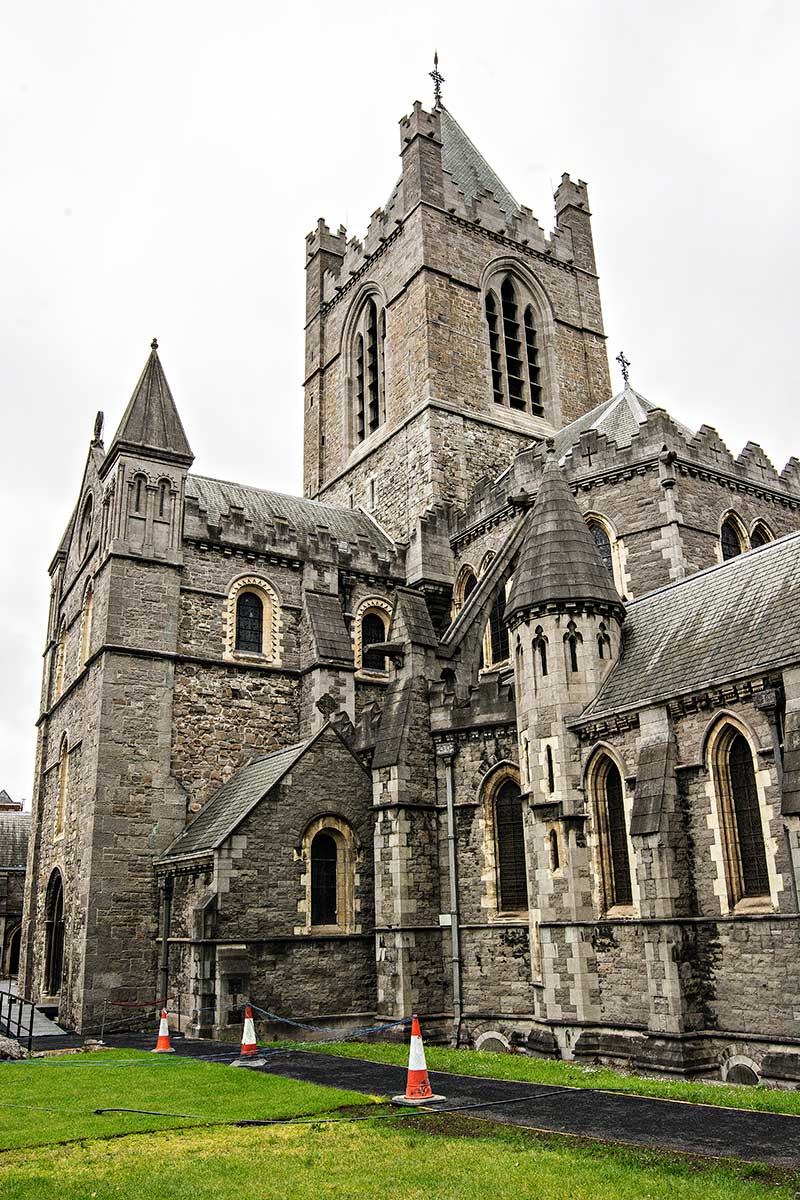
The current cathedral dates from 1172. The Normans believed in using stone and redid many cathedrals. Norman architecture is a combination of Romanesque and Gothic. Romanesque style incorporates Roman classical forms with heavy use of semicircular arches framed by slender Roman columns with decorative geometric carvings in the arches.
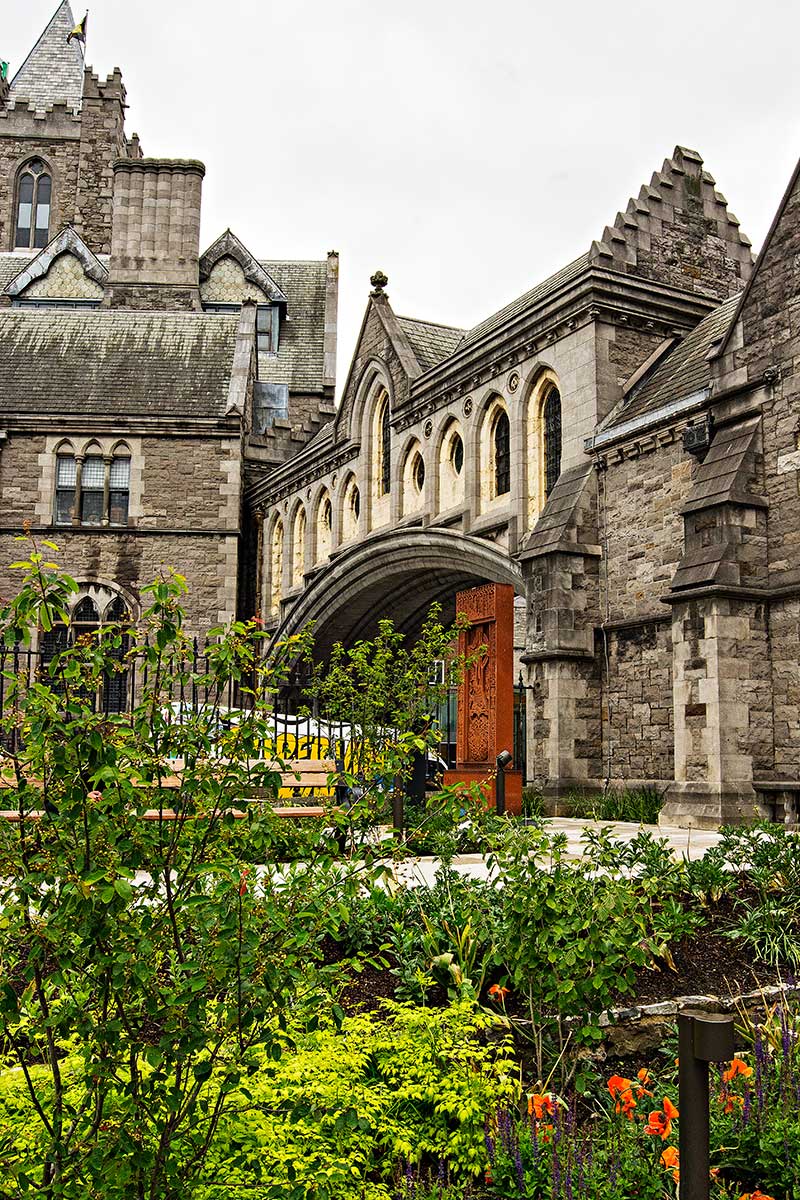
The cathedral was extensively renovated and rebuilt from 1871 to 1878 by George Street. The footbridge from the synod house on the left to the cathedral cost £230,000 in the 19th century or €26 million today!
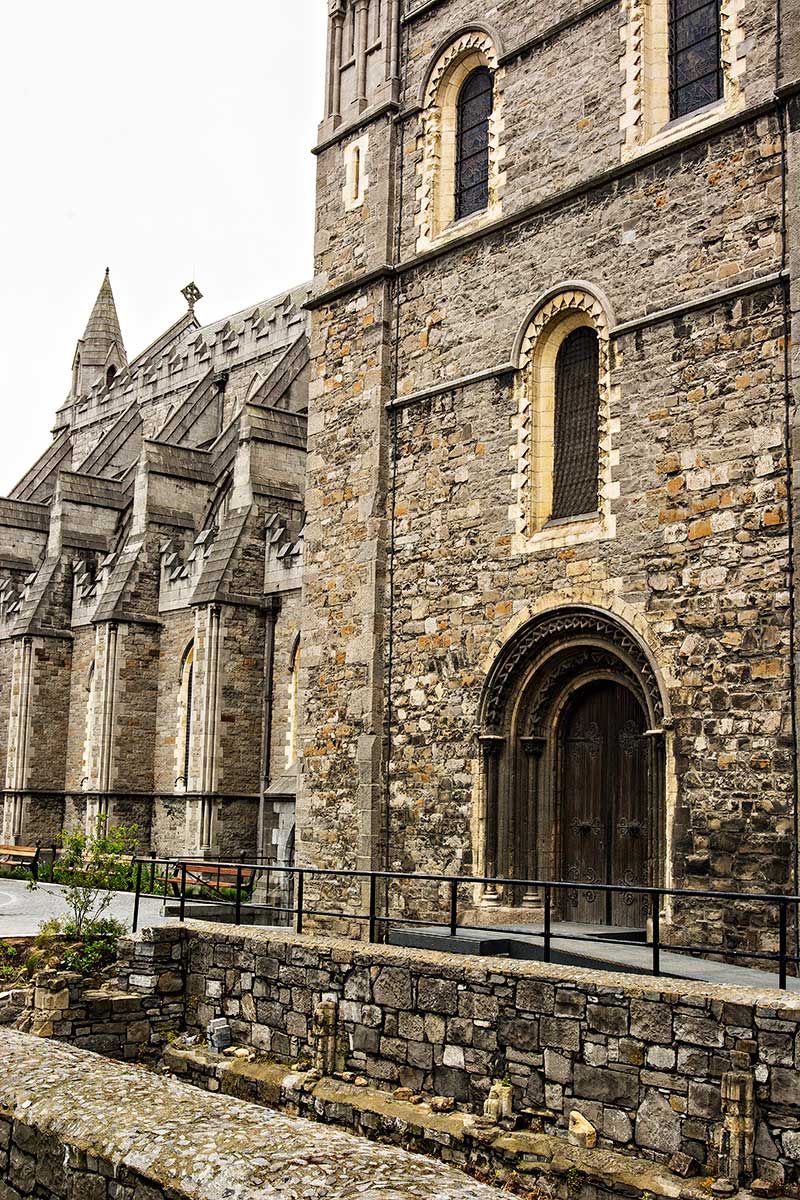
The foundation ruins in the foreground were the Chapter or Meeting House of the Augustinians between 1163 and 1537.
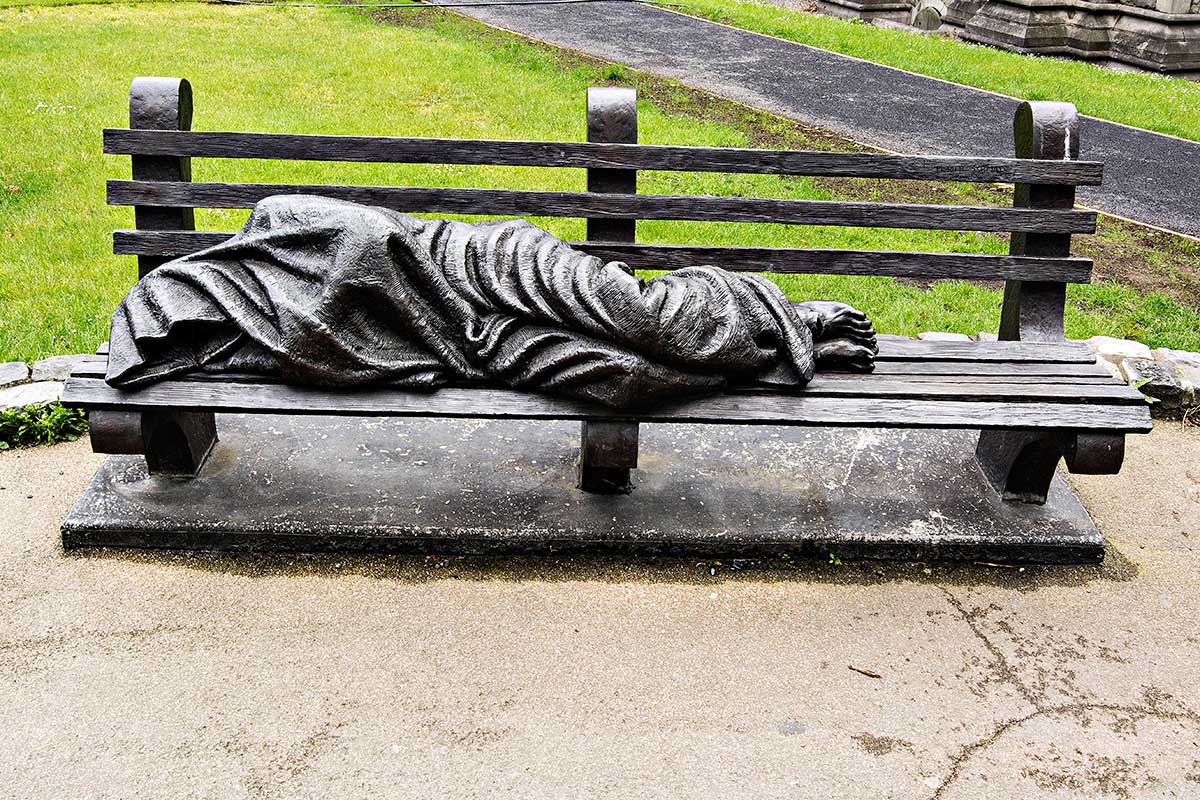
I was taken aback by a cast bronze sculpture of a person hidden beneath blankets on a park bench. There was no sign or explanation. After some research I learned that Canadian sculptor Tim Schmalz designed it to get people to reflect on the plight of the homeless. In fact, the statue is titled Homeless Jesus — I had not noticed the holes in his feet.
2. Dublin Castle
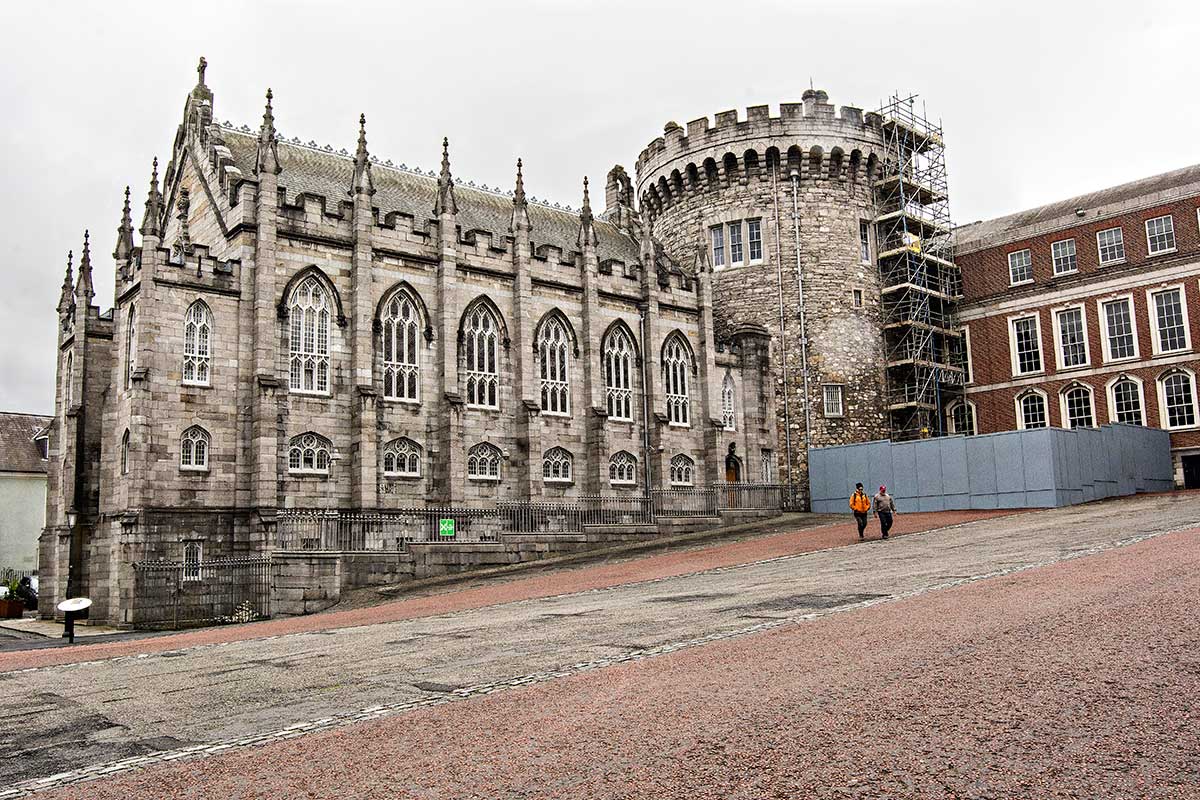
Over 30,000 castles and ruins are sprinkled across the Emerald Island. Dublin Castle played a significant role in Irish history. It was the centre of British rule until the independence of Ireland in 1922. It served as the residence of the Viceroy of Ireland as well as the administrative centre of the colony of Ireland.
Dublin Castle, started in 1204 by King John of England, has a typical Norman courtyard design. The castle was built near the dark pool (“Dubh Linn”), which gave Dublin its name. The Record Tower (1228) above is the sole surviving tower of this medieval castle.
To its left is the Chapel Royal. It looks Gothic but it is not even medieval. It was completed in 1814! This magnificent Gothic Revival chapel wears a crown of pinnacles rising above Gothic arched windows. It was a place of worship solely for the vice-regal household.
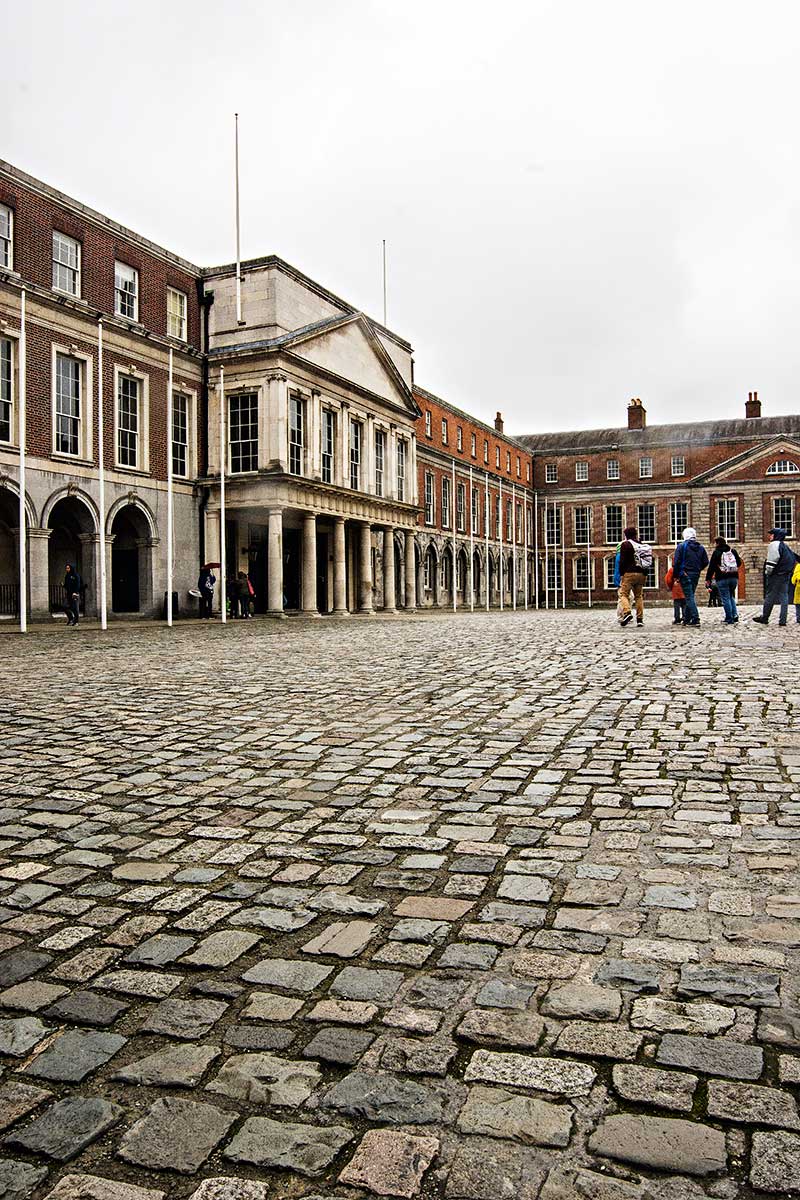
The State Apartments dating from the 17th and 18th century make this look more like a palace than a castle. There are many ornate rooms where the social life of the aristocracy took place.
Trinity College
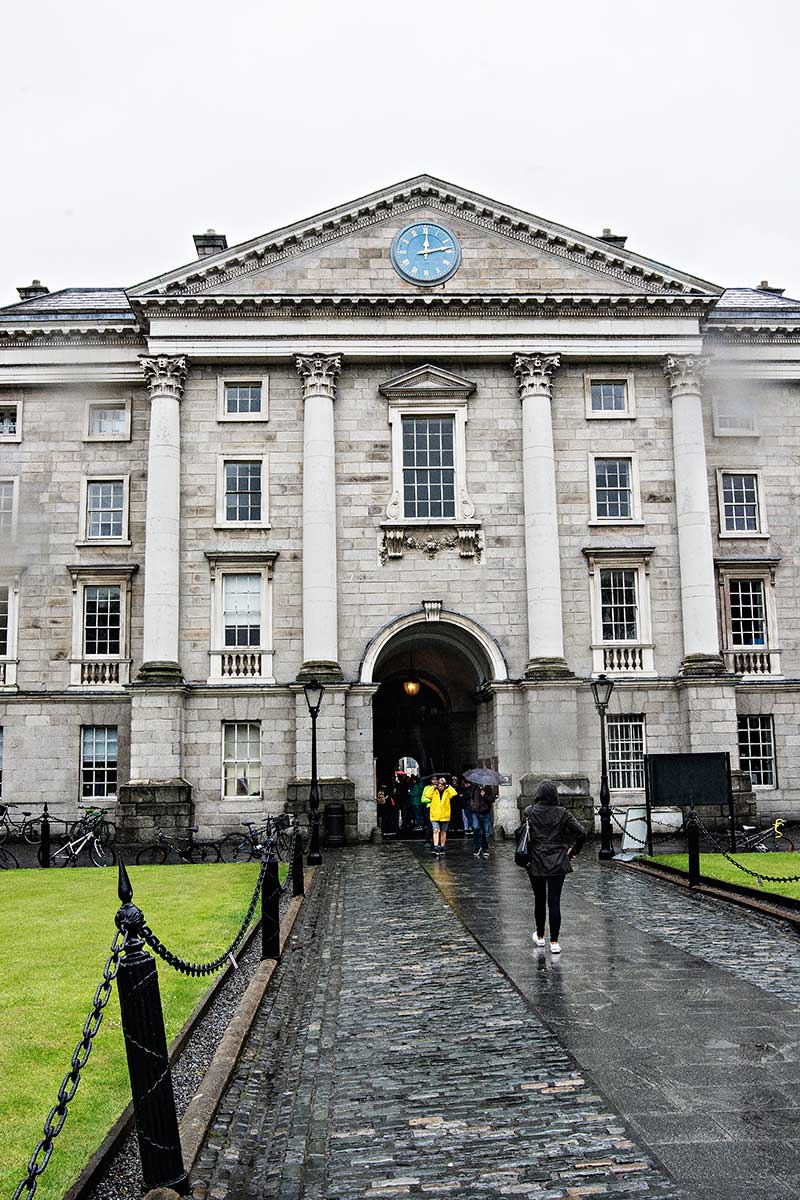
The archbishop of Dublin requested a royal charter from Queen Elizabeth I to create a university for scholars and clergy. Its’ purpose was to bolster the Protestant Reformation in Ireland. That is the reason it was supported by Queen Elizabeth I.
Trinity College, aka the University of Dublin, was founded by in 1592. Regent House above is the college administration and visitor reception area.
It was built far from the centre of Dublin on the location of one of the many monasteries that were shut down. Henry VIII enacted the Dissolution of the Monasteries 1536-1541 which closed down and sold the assets of the Catholic Church to fund Henry’s wars.
Trinity was created as a university solely for Protestant men. In fact, during Cromwell’s conquest in the 1650s, Catholics were actually banned from living within Dublin!! After seeing all the destruction and killing in Ireland caused by Cromwell, one can really hate his fascist mentality.
Trinity was modelled after the collegiate universities of Oxford and Cambridge, and has always been one of the top universities in the British Empire.
The College opened its doors to Catholics in 1793 and women in 1904. Catholics were prohibited from gaining positions of prestige such as scholar or professor. In 1873 all religious tests were abolished. However, the Catholic church banned Catholic attendance from 1871 until 1970.
3. Old Library
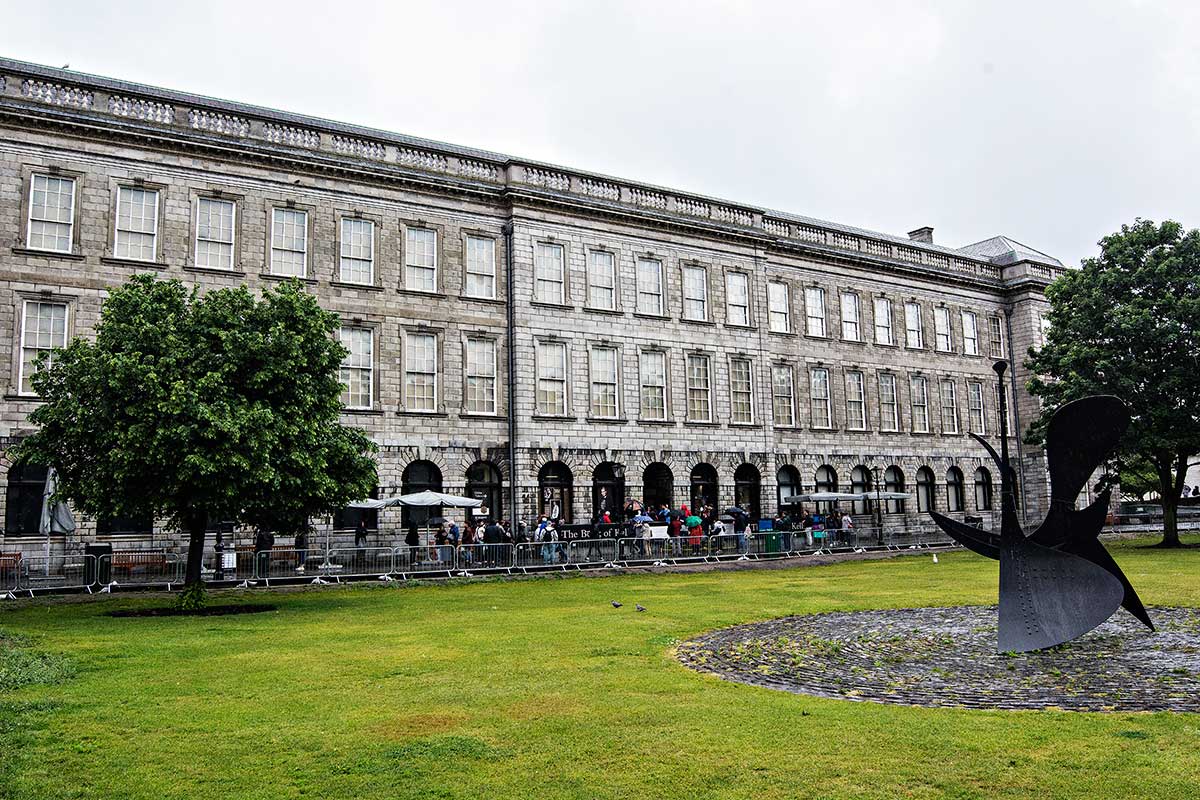
Trinity College is most famous for its Old Library lined floor to ceiling with books. Trinity is a legal deposit library for Ireland and Great Britain; that is, it gets a copy of every book ever published. It currently contains over 6.2 million printed books. It also has significant quantities of manuscripts. They have many beautifully illustrated Christian texts besides the Book of Kells. Unfortunately the Book of Kells room was undergoing maintenance when we were there.
The Book of Kells (fee €11-14) is one of the great masterpieces of Irish Christian culture. During Oliver Cromwell’s invasion of Kells (near Trim) in 1654, the manuscript was sent to Dublin for safekeeping! It was donated to Trinity College in 1661.
There are several excellent web sites that describe the Book of Kells such as the article by M. Kearney below. As tourists we tend to look at how beautiful the image is, how colourful or how ornate. We may not know that these illuminations are done on vellum not paper. It is estimated that the skins of 185 calves were needed for this manuscript. The article below is a good example of the need to pay attention to details. Look at the figure on the upper right.
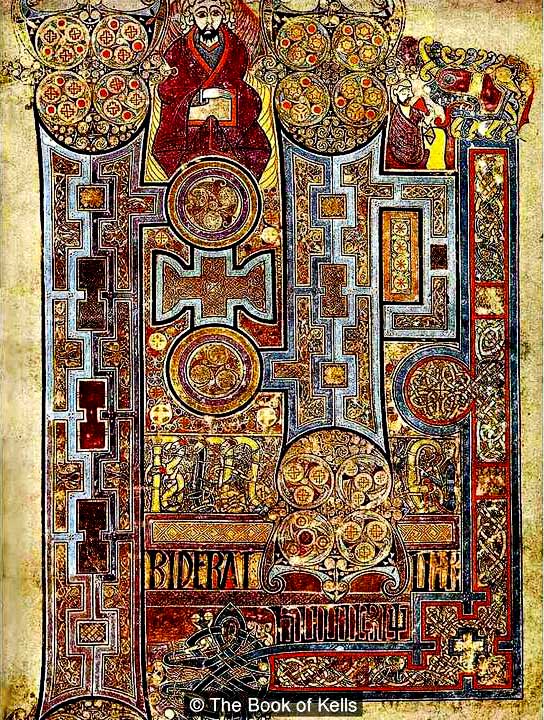
"The whole page only contains four words, In principio erat verbum: In the beginning was the Word. Then there is the figure of St John himself, with large thoughtful eyes, who is shown holding a book. But far less reputably to his right, there is a smaller figure who seems to be knocking back a goblet of wine, his eyes closed in a alcoholic stupor and totally oblivious of a gigantic monster looming above him."The Book of Kells, M. Kearney, BBC 2016-04-26
One has to wonder if there was some symbolism for this depiction or was the monk inserting some humour. The Book of Kells is a beautifully illustrated set of four Gospels. Since most people then could not read, especially Latin, illustrations and frescoes were the principle means of teaching. But despite its renown, not much is known about its origins.
William Leckey Statue
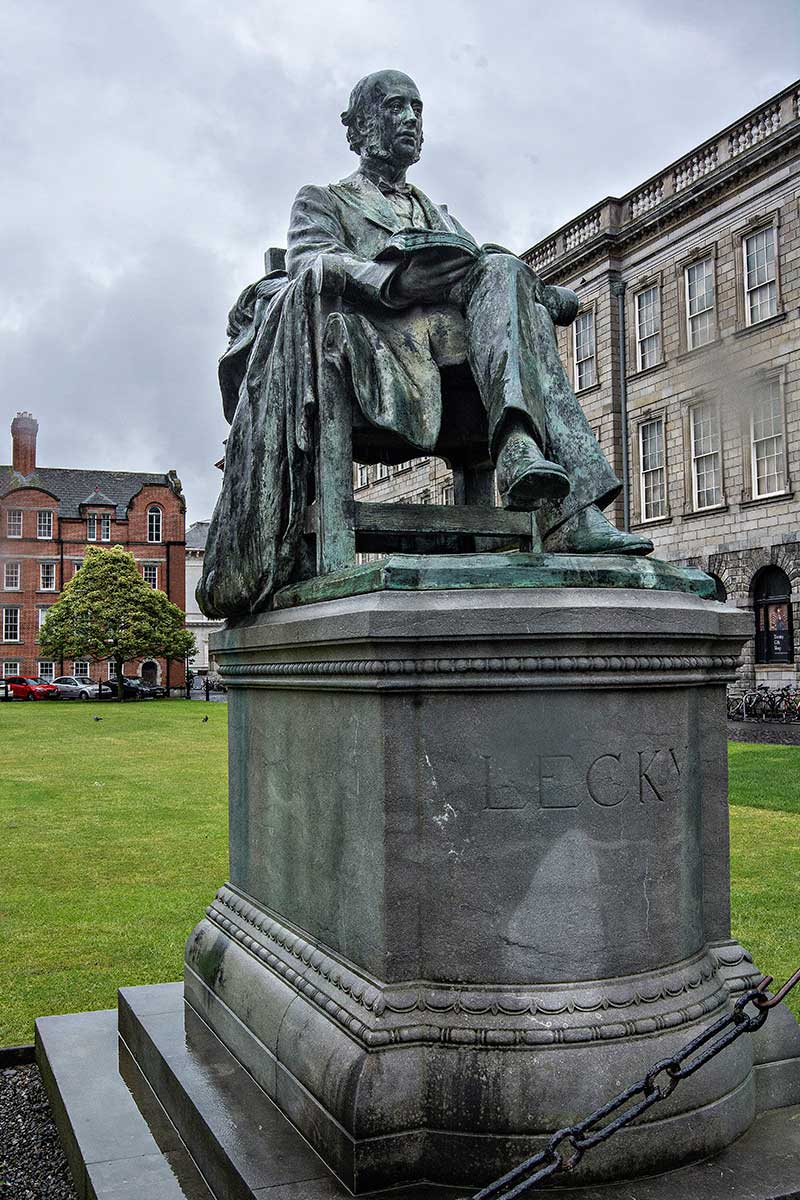
William Leckey was an Irish historian, essayist, and political theorist with Whig proclivities. His major work was an eight-volume History of England during the Eighteenth Century. The statue dates to 1910.
4. Campanile
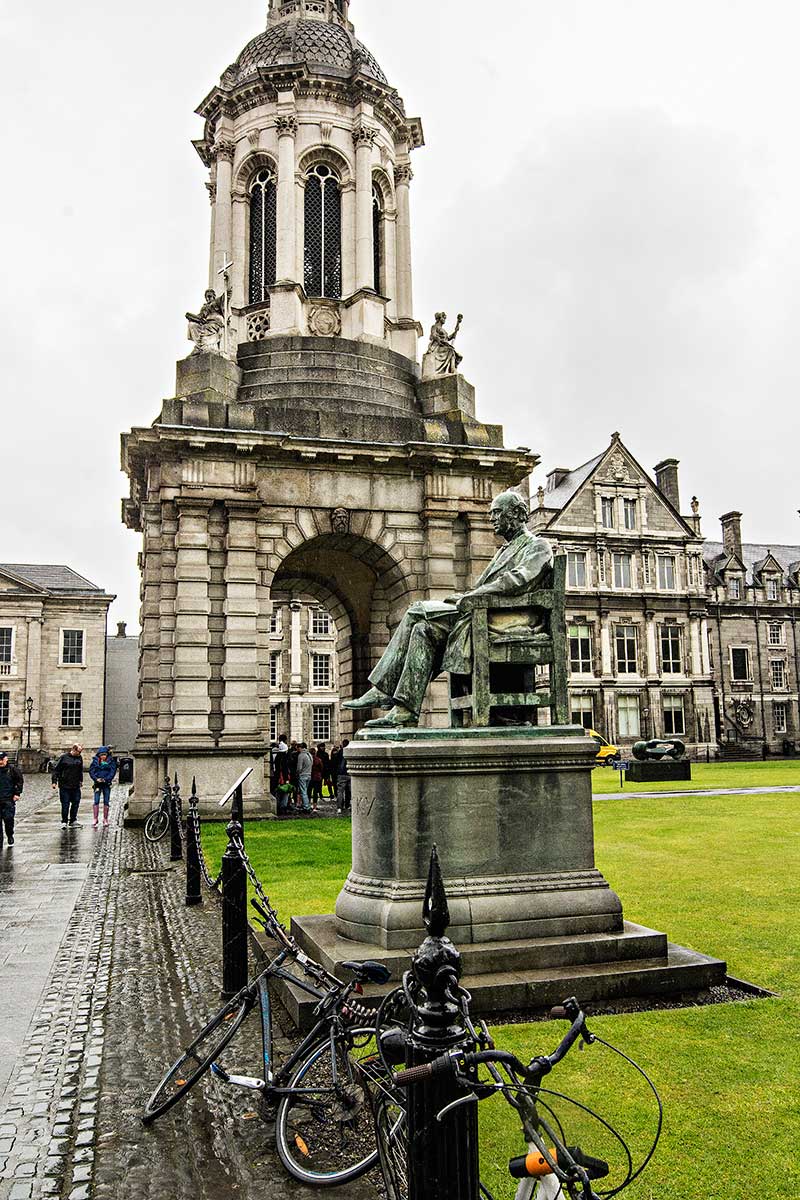
Campanile is an Italian architectural term for bell tower. The Campanile of Pisa, Florence and Venice are so famous you already know them. This campanile was donated by the Archbishop of Armagh, Lord John Beresford in 1853. He graduated from Oxford with a Master of Arts. He was married but joined the clergy in 1797. He was Chancellor of the Univ. of Dublin between 1851 and 1862.
A tour group hides from the rain under the Campanile while a student guide tells gossip about Trinity College. She mentioned that there was an old superstition that any student who passes beneath the campanile will fail their exams. As a result, some students never walk through the arches until they graduate Trinity College. On graduation day, a celebratory walk under the campanile is a rite of passage
The belfry is a cylindrical chamber encircled by Corinthian columns, between which are tall, round-arched tracery windows. Seated around the belfry are figures representing Divinity, Science, Medicine and Law. Clearly, those were considered the highest faculties in those days.
Language
But perhaps the most important faculty historically was English. The Irish have made an big impact on the English language. Some of the words they introduced include brogue, hooligan, slob and Tories.
A Dublin theatre proprietor Richard Daly made a bet that he could, within 48 hours, make a nonsense word known throughout the city, and that the public would supply a meaning for it! After a performance one evening, he gave his staff cards with the word written on them, and told them to write the word on walls around the city. The next day the strange word was the talk of the town and so the word quiz was invented.
The word boycott was named after Capt. Boycott, who is the villain in this story. He was the agent for an absentee English landlord, who refused to lower rents when there was a bad growing season. Capt. Boycott then started to evict tenants who could not pay. The town not only shunned him but refused to work for him. He had no one to perform the harvest. And so the word boycott was born.
5. Chapel
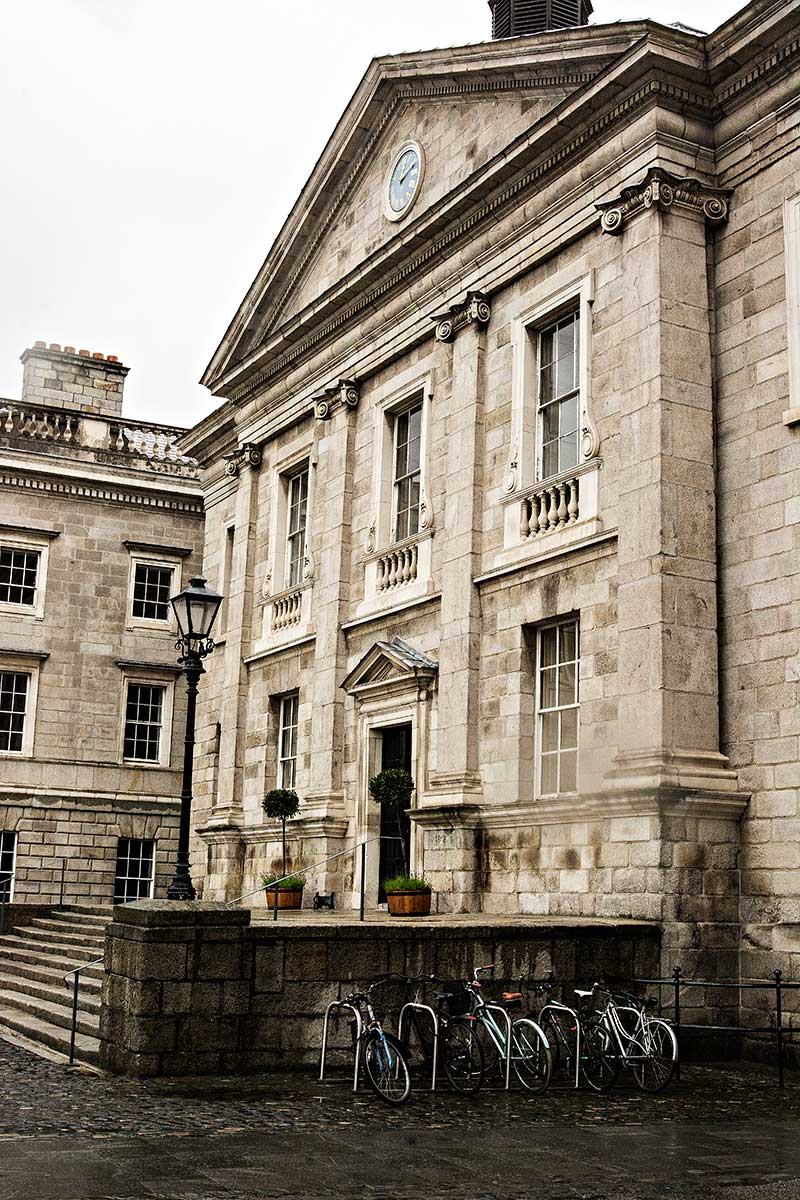
The Chapel (1798) was designed by King George III’s architect, Sir William Chambers. The buildings on the central campus were imposing but austere.
Trinity College scholars are students who excel in a special set of examinations. Scholars are given free campus accommodation, free carvery dinner with a pint of Guinness each night, and a glass of brandy or a pint of Guinness – depending who you ask – during their exams.
6. Buttery Food Court
Speaking of food, around the corner is the student cafeteria where I had a very nice lunch and a superb Lavazza cappuccino while I waited for the rain to stop.
7. Sphere in a Sphere
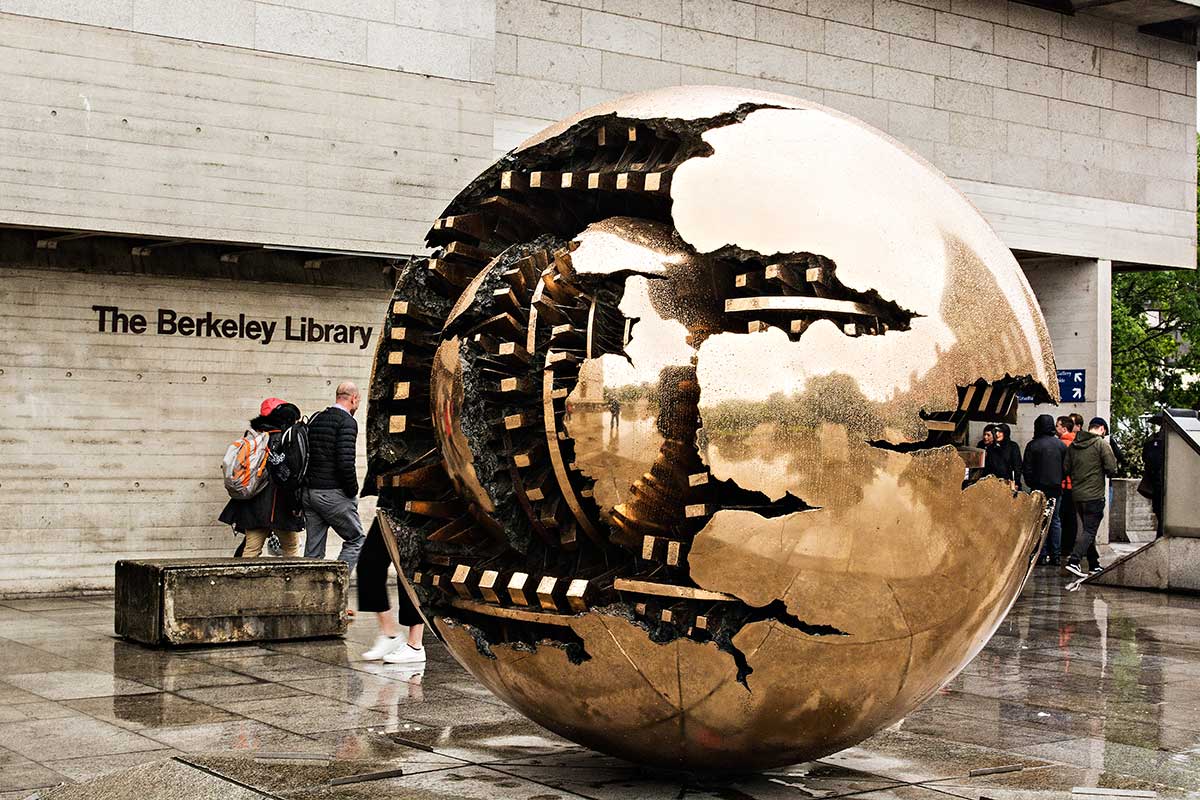
The bronze Sphere Within Sphere (Sfera con sfera) is by Italian sculptor Arnaldo Pomodoro, which has been much copied around the world, especially in the Cortile (courtyard) of the Vatican Museums.
8. Museum Building
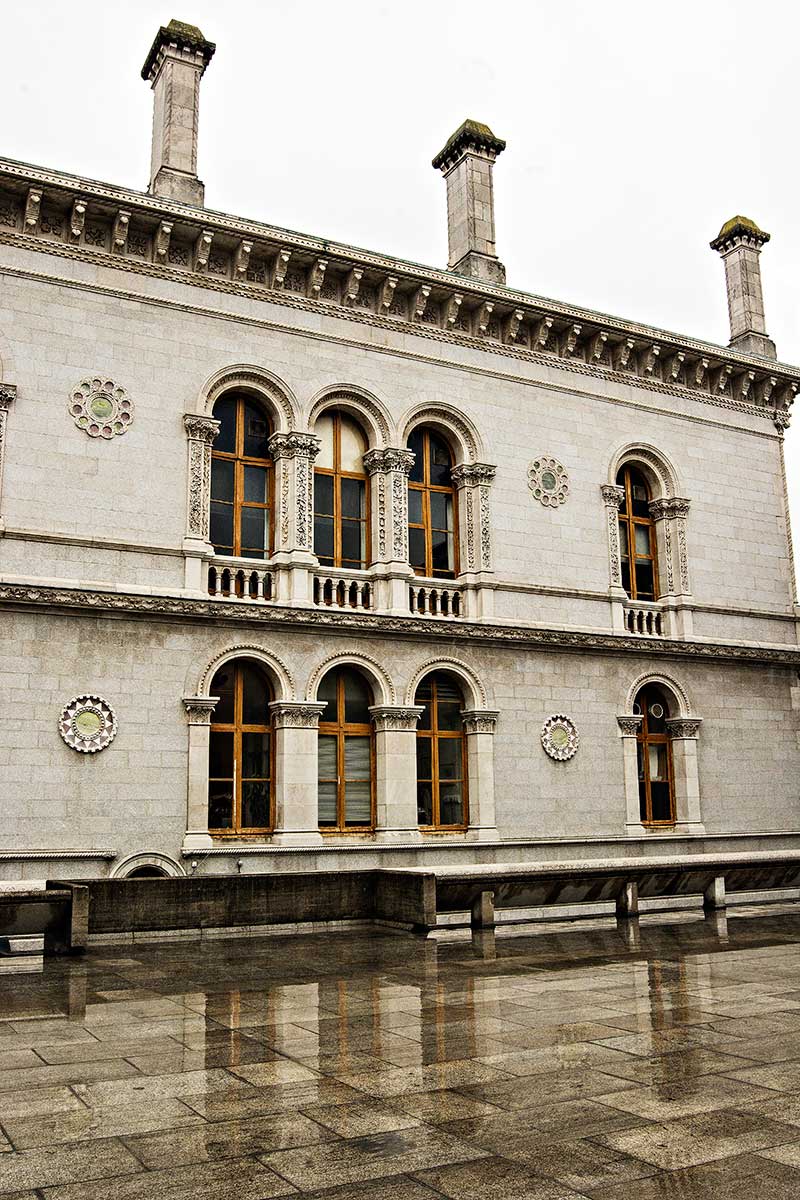
The Museum Building is home to the Geology, Geography, and Engineering departments. It was my favourite architecture, but then I did work in Italy for four years. This Palazzo style building was completed in 1857 at a cost £28,790. The pedestrian bridge at Christ Church Cathedral cost ten times as much!
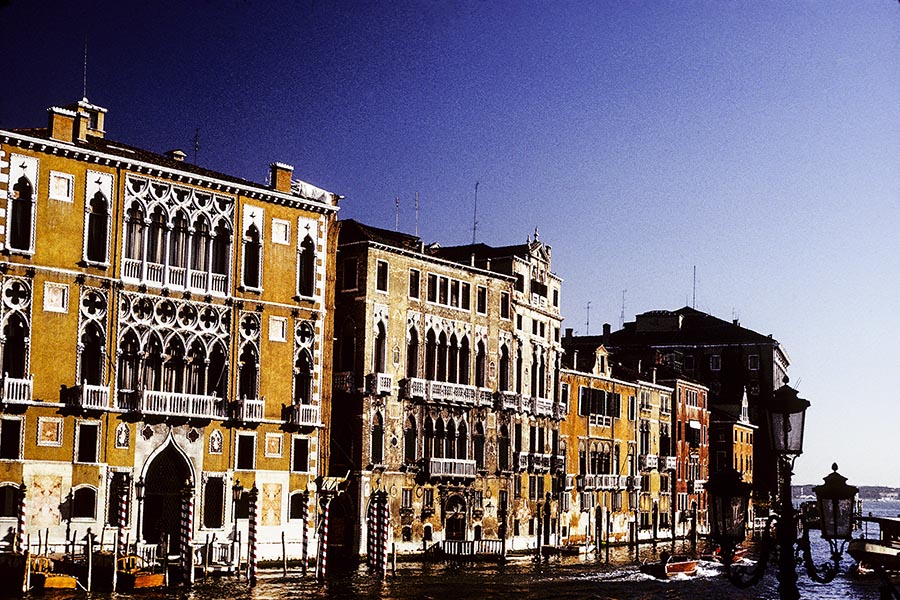
Several web articles and even Trinity College say that the Museum Building was inspired by the “Byzantine” architecture of Venice. However, as you can see in the photo of the Grand Canal above, the Museum Building lacks the pointed arches of the Venetian style – which is not Byzantine but is called Saracenic-Gothic.
The Saracenic-Gothic style is unique to Venice, which was the most powerful city in Western Europe during the Gothic Era until the Renaissance. The Venetians were a naval power and controlled the Adriatic and eastern Mediterranean. They were the only nation that could transport the Crusaders to the Holy Land to fight the Saracens. They made a fortune on their ferry service!
If you look carefully, the Venetian arches are a more upward pointed than the Gothic. That is the Saracenic or Islamic influence in their architecture.
BTW, “Byzantine Empire” is bad 16th century history invented by a German historian: it was called the Roman Empire by the people of that time. Their architecture style is classical Roman. In 330 AD, Constantine moved the capital of the Roman Empire to Constantinople — it still was the Roman Empire, even when Rome the city fell.
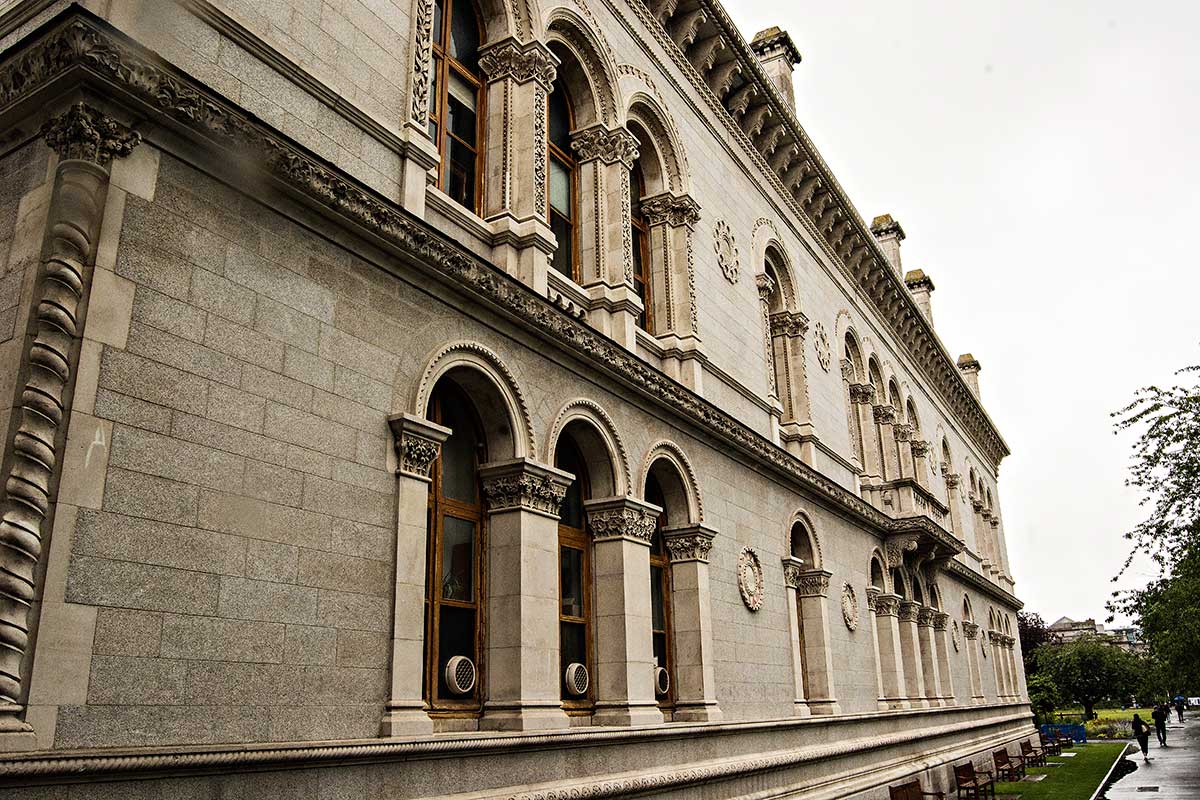
The Museum Building is primarily Romanesque in style as shown by its triple semi-circular arches, and highly decorated pilaster capitals.
Literature
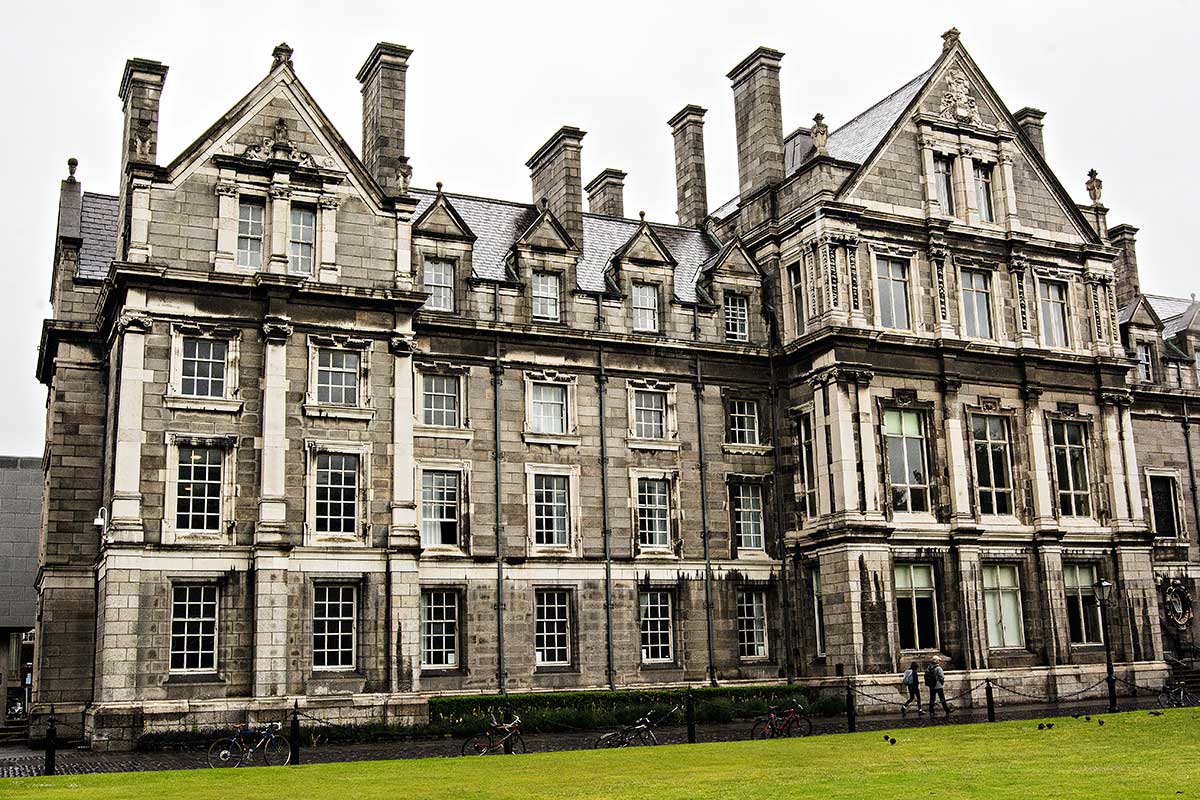
Standing in front of the Victorian Graduates Memorial Building, it is time to pay homage to some of the most important graduates and authors, many of whom lived in Dublin — Oscar Wilde, George Bernard Shaw, Samuel Beckett, James Joyce, Jonathan Swift, William Butler Yeats and Bram Stoker.
All these names are familiar but who is Bram Stoker? He is author of the extremely famous 1897 story about a vampire! Count Dracula was modelled on his friend, the actor Sir Henry Irving. I wonder what Henry thought about that? One inspiration for his story was the Irish legend of Abhartach, an evil chieftain who rose from his grave every night to drink the blood of his subjects.
Bram lived at 30 Kildare Street right near Trinity College, where he graduated. He worked at Dublin Castle as a civil servant.
Notice that these individuals were literary giants in English not Irish (Gaelic). Thanks to 750 years of occupation by the British, very few people speak Irish today. In fact, Polish is the second most spoken language on the Emerald Island!
Georgian Dublin
The Irish Parliament was abolished in 1801, when Ireland becoming a part of the new United Kingdom of Great Britain and Ireland under the Act of Union.
The Georgian Period 1714-1830 — named for the four consecutive King George’s — is synonymous with a neoclassical art and architecture style. Dublin became an elegant capital of British Ireland and the second most important city of the United Kingdom.
9. Merrion Square
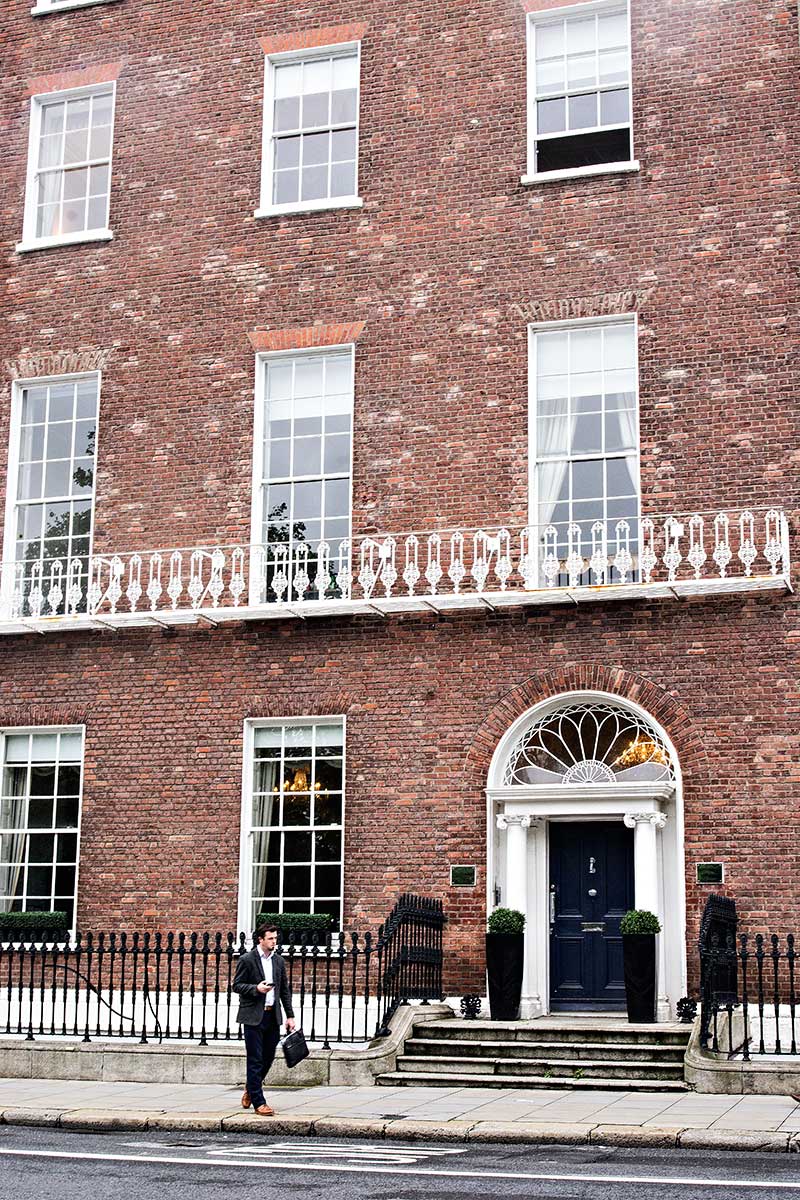
When Merrion Square was begun in 1762, this area was farmland on the outskirts of Dublin. Most tourists will focus on the green space, the statues, or the grass-covered hump at the corner of Fitzwilliam Street Lower, an entrance to a World War II air raid shelter.
You will be forgiven if you hardly notice the buildings lining the squares of southern Dublin. But these 250 year-old buildings are still in pristine shape. That is a testament to how well built they were.
The buildings are understated and characterized by proportion, balance, and symmetry. I noticed they all seem to have an odd number of window bays with the door in the centre and one window bay above it. The regularity of house fronts along a street was a desirable feature of Georgian town planning. In fact, a standard mathematical ratio was used to determine the height of a window based on its width.
The Georgian style is also based on the classical forms of the Italian Renaissance period. It was invented by famous English architects like Christopher Wren, designer of St Paul’s Cathedral and John Nash, designer of Buckingham Palace.
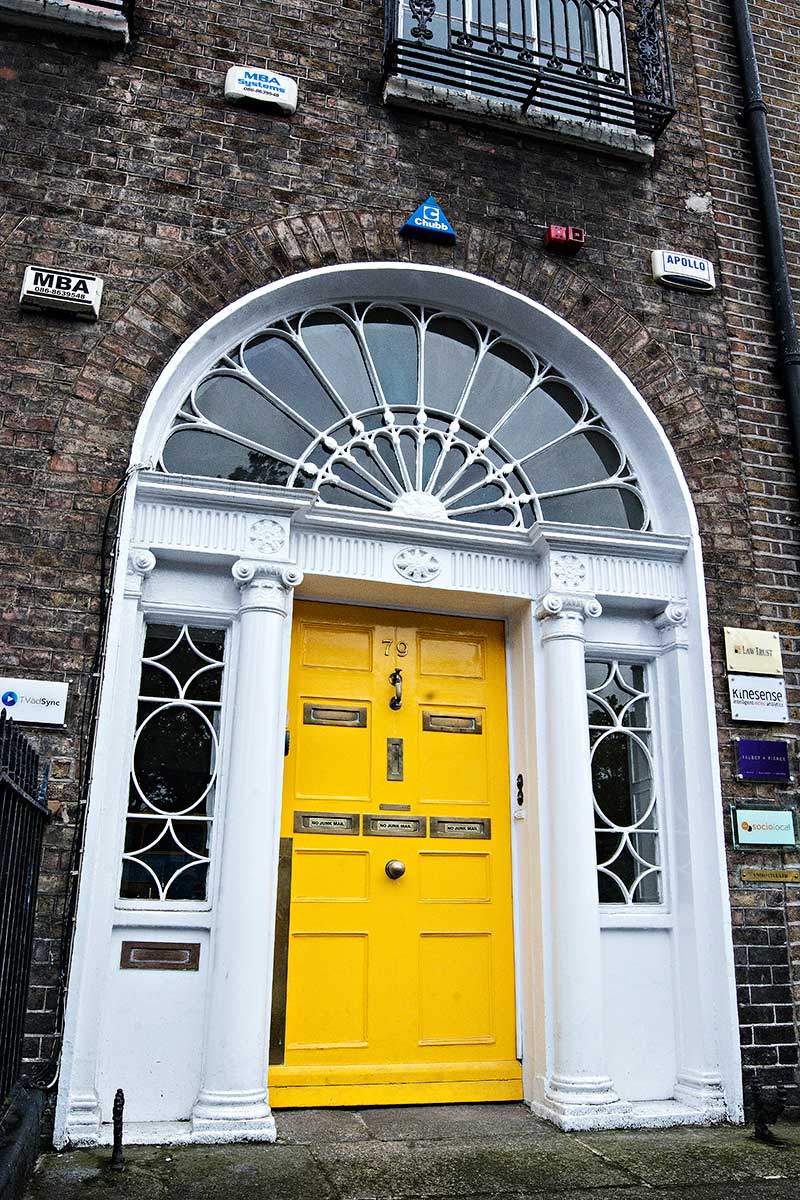
Now it is time to look at the details to see what makes Georgian architecture interesting. Closely examine the transom window or fanlight over the colourful front doors. A transom is a horizontal beam atop a door. The fanlight could be opened to provide cross-ventilation while maintaining security in the pre-air conditioning era. The phrase “over the transom” refers to works submitted for publication without being solicited. The manuscripts would be thrown through the transom window.
Other neoclassical features are the carved pediments, Ionic pilasters, and cornice (horizontal decorative molding at the top of a building or door) with dentils (literally teeth).
The Georgian buildings in Canada and the United States have a similar design to those in the UK due to the use of pattern books drawn up by professional architects.
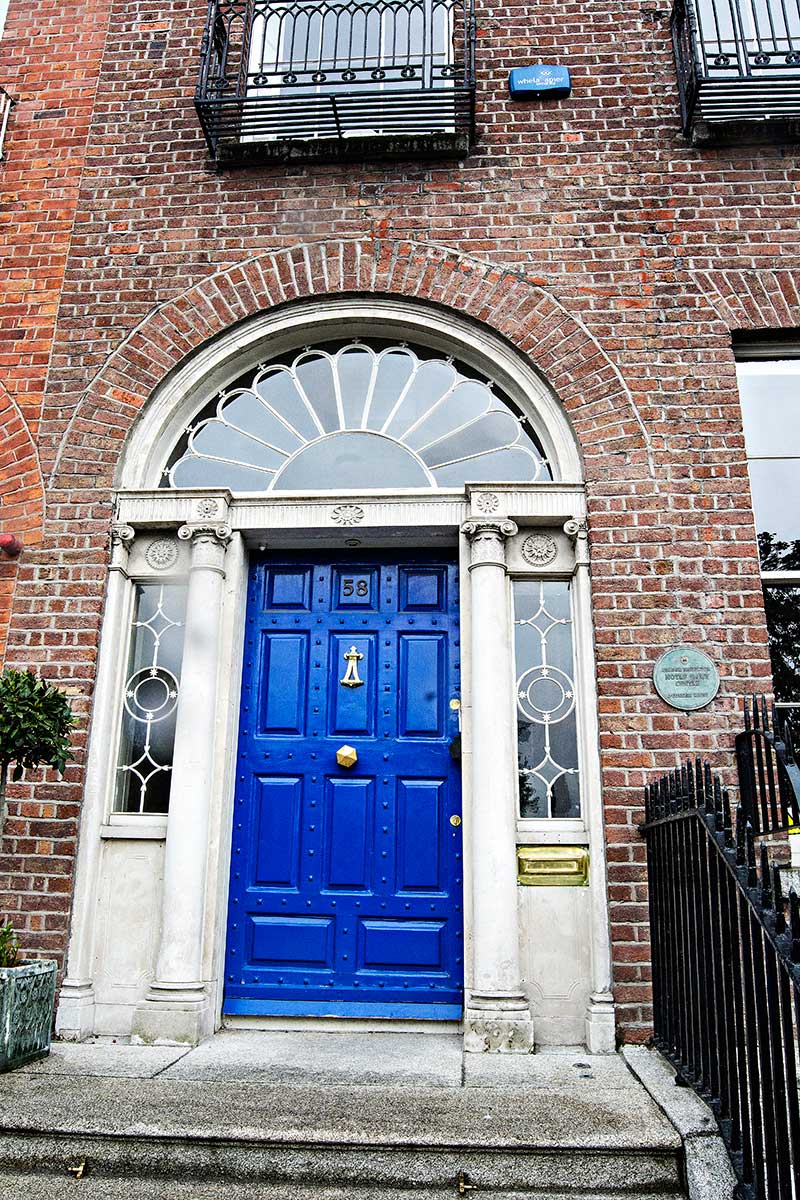
Back in 18th century, all the bourgeoisie moved to the fashionable Merrion Square area. Oscar Wilde lived at #1 as a child, Daniel O’Connell (see next post on Dublin) at #58 above, and W. B. Yeats at #82.
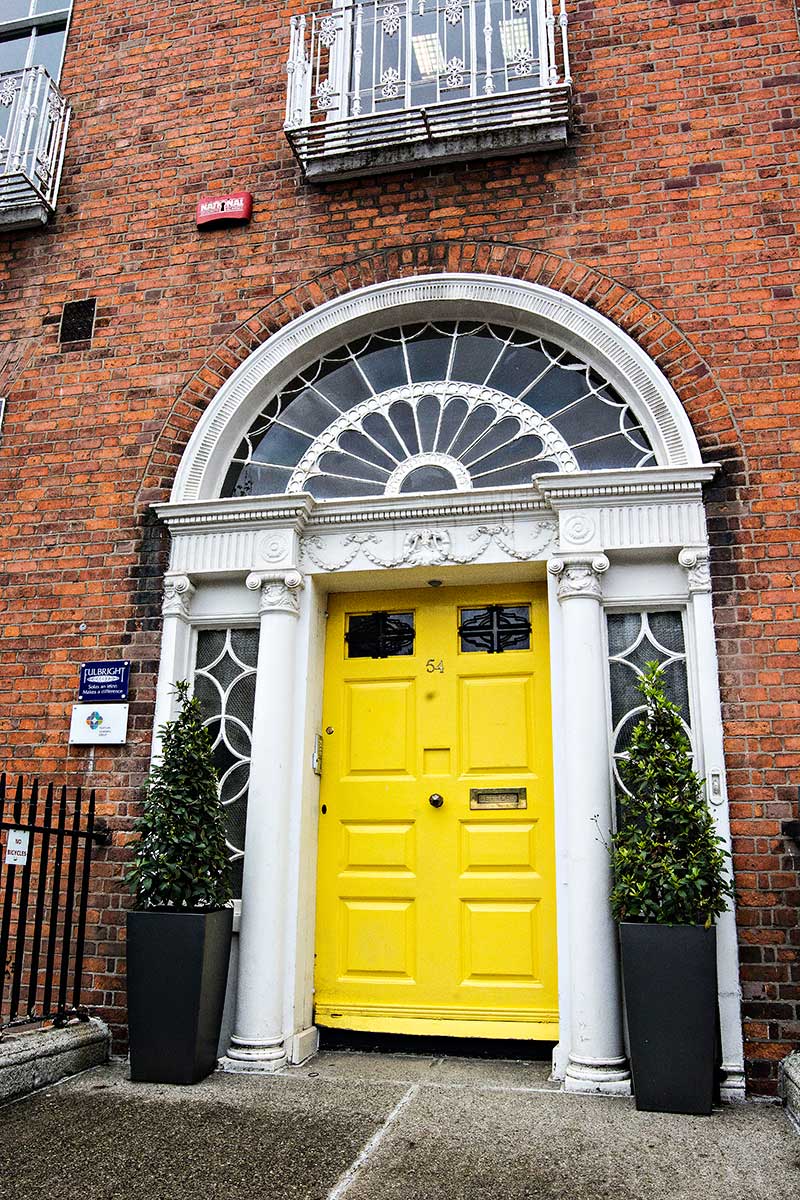
Today, most of the houses are commercial; for instance, #54 is the Fulbright (Scholar) Commission.
Other Posts You May Like
This is part 2 of the Dublin tour.
If your time is limited, here are places close to Dublin that you can visit.
Custom Maps and Facts to Plan your Itinerary
Ireland FAQ answers your questions such as when should I go, what is the best clothing, how much time do I need, how safe is Ireland, should I pay in Euros or my own currency, et al.
Ireland’s Best Sights — the top eight drives in Ireland


You must be logged in to post a comment.